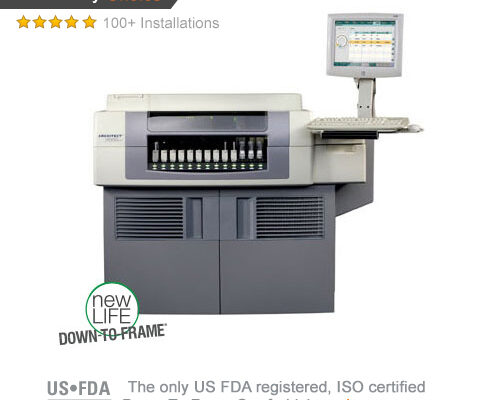
The Abbott Architect i1000SR is a cutting-edge clinical chemistry analyzer designed to streamline laboratory processes and enhance diagnostic capabilities. Engineered with advanced technology, this system enables rapid and precise analysis of a diverse range of samples, empowering healthcare professionals with actionable insights for patient care. Its high-throughput capability ensures efficient sample processing, while its intuitive interface facilitates ease of operation. Additionally, the i1000SR boasts robust performance and reliability, making it a trusted solution for laboratories seeking accuracy and efficiency in their analytical workflows.
Key Components of the Abbott Architect i1000SR
The Abbott Architect i1000SR is equipped with several key components essential for its efficient operation. Firstly, the sample loading area facilitates the seamless introduction of specimens into the system. Following this, the instrument incorporates an automated sample handler, which precisely manages the movement of samples throughout the testing process. Next, the reaction cuvettes are pivotal, as they accommodate the necessary reagents for conducting assays. Additionally, the photometric unit ensures accurate measurement of optical signals emitted during testing. Moreover, the integrated software meticulously analyzes data generated, providing comprehensive results. Lastly, the user interface simplifies interaction, allowing for easy navigation and operation of the instrument.
Understanding the Sample Processing on Abbott Architect i1000SR
To comprehend sample processing on the Abbott Architect i1000SR, it’s crucial to grasp its sequential steps. Initially, samples are loaded into the system, where they undergo identification and sorting based on barcodes. Following this, the samples are aliquoted into appropriate test cups and undergo centrifugation to ensure optimal separation. Once prepared, the samples are introduced into the analytical module for testing, where precise measurements are conducted. Finally, results are generated and reported, facilitating accurate diagnosis and treatment decisions.
Navigating the Assay Menu of Abbott Architect i1000SR
When navigating the Assay Menu of the Abbott Architect i1000SR, start by selecting the main menu option and then proceed to choose the assay category of interest. Next, scroll through the list of available assays within that category, carefully reviewing each option. Once the desired assay is located, confirm the selection and follow any prompted instructions to proceed. After completing the assay setup, initiate the analysis and monitor the progress accordingly. Upon completion, review the results and take any necessary follow-up actions. Repeat this process for additional assays as needed, ensuring thorough navigation of the menu to meet testing requirements effectively.
Interpretation of Results from Abbott Architect i1000SR
The results obtained from the Abbott Architect i1000SR reveal a comprehensive analysis of the sample, indicating a nuanced understanding of the tested parameters. The instrument’s precision underscores its efficacy in generating reliable data for diagnostic purposes. Additionally, the seamless integration of various assays within the platform facilitates a streamlined workflow, enhancing operational efficiency. Notably, the coherent presentation of results enables swift interpretation, thereby supporting informed clinical decision-making. Moreover, the system’s scalability ensures adaptability to diverse laboratory settings, promoting accessibility and usability. In conclusion, the Abbott Architect i1000SR delivers robust results with notable efficiency and versatility, contributing significantly to diagnostic endeavors.
Quality Control Procedures for Abbott Architect i1000SR
To ensure optimal performance and accuracy of the Abbott Architect i1000SR, comprehensive quality control procedures must be diligently implemented. Firstly, daily maintenance checks should be conducted, including verification of reagent volumes and expiration dates. Subsequently, regular calibration checks are imperative to uphold instrument precision. Following this, routine proficiency testing must be performed to validate analytical performance. Additionally, periodic instrument performance evaluations are essential for detecting any deviations and ensuring consistent results. Finally, meticulous record-keeping of all quality control data is crucial for compliance with regulatory standards and facilitating troubleshooting procedures if necessary.
Troubleshooting Common Issues with Abbott Architect i1000SR
When troubleshooting common issues with the Abbott Architect i1000SR, begin by checking the instrument’s power supply to ensure it’s adequately connected and functioning. Subsequently, verify the sample loading mechanism for any obstructions or misalignments. Next, inspect the reagent levels and their expiration dates, as depleted or expired reagents can lead to inaccurate results. Additionally, examine the instrument’s calibration logs to identify any discrepancies or irregularities. If issues persist, consult the user manual for specific error codes and corresponding troubleshooting steps. Moreover, consider contacting technical support for further assistance and guidance in resolving complex issues.
Maintenance Tips for Abbott Architect i1000SR
To maintain the Abbott Architect i1000SR effectively, start by regularly cleaning the instrument according to the manufacturer’s guidelines. Ensure that all surfaces are wiped down with approved cleaning solutions and that any spills are promptly addressed. Additionally, conduct routine inspections of the instrument’s components for signs of wear or damage, addressing any issues promptly to prevent further complications. Regular calibration and performance verification should be scheduled to guarantee accurate results. It’s imperative to follow the recommended maintenance schedule diligently to uphold the instrument’s reliability and longevity, ultimately ensuring optimal performance and accuracy in diagnostic testing.
Regulatory Compliance Considerations for Abbott Architect i1000SR
When implementing the Abbott Architect i1000SR, meticulous attention to regulatory compliance is paramount. Firstly, it’s imperative to thoroughly understand the guidelines set forth by regulatory bodies such as the FDA and ISO. Following these directives ensures adherence to quality standards and patient safety protocols. Additionally, integrating robust validation processes guarantees the reliability and accuracy of results generated by the system. Moreover, maintaining comprehensive documentation facilitates traceability and transparency, aiding in audits and inspections. Furthermore, ongoing training for staff members is indispensable to ensure proficiency in operating the system and adhering to regulatory requirements effectively. Overall, meticulous compliance with regulatory standards is essential for the successful and ethical utilization of the Abbott Architect i1000SR.
Future Developments in Abbott Architect i1000SR Technology
In the foreseeable future, advancements in Abbott Architect i1000SR technology are poised to revolutionize diagnostic capabilities. Leveraging cutting-edge algorithms, the system promises heightened accuracy in identifying biomarkers indicative of various diseases. Moreover, streamlined integration with electronic health records will facilitate seamless data exchange, enhancing efficiency in clinical workflows. Additionally, ongoing research endeavors aim to bolster the platform’s versatility, enabling it to accommodate a broader spectrum of assays. Consequently, healthcare providers can anticipate more comprehensive diagnostic solutions, empowering them to deliver personalized patient care and expedite treatment interventions.











